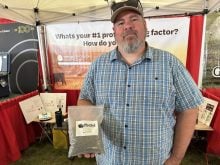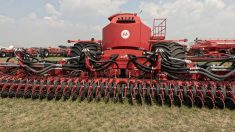Q: What’s the ideal seed-placed starter fertilizer blend for soybeans?
A: Legume plants have a high demand for phosphorus. Phosphorus is critical in many lifecycle processes from photosynthesis to nodulation. Currently, many acres of soybeans are still grown without enough fertilizer to offset nutrient removal by the crop. This may lead to nutrient deficiencies in the future. The practice of not applying any fertilizer in the seed row made its way to Western Canada from the northern United States. Unfortunately, there were important variables not realized, with the most important one being the difference in seeders. The recommendation to not put any fertilizer down with the seed largely came from a reduced seedbed utilization (SBU) from planters and wide-row spacing.
Read Also

Claas brings 1000 Series SP forage harvesters to Canada
In mid-August, Claas unveiled its new line of Jaguar forage harvesters at an event in Visalia, California, deep in the heart of that state’s dairy region.
Soybeans are quite sensitive to seed-placed fertilizer. Even with the use of air drills and increased seedbed utilization, the maximum amount of phosphorus fertilizer that can be applied in the seed row is about 20 lbs. actual phosphorus per acre. Growers wanting to replace the phosphorus that soybeans use will have to look at adding phosphorus to other areas of the crop rotation or banding it into the soil at the time of seeding.
Overall, phosphorus is the main nutrient to focus on for soybeans at the time of seeding. It is estimated that a 40 bu./ac. soybean crop will remove about 29 lbs. of phosphorus/acre. This is more than what can be safely put down in the seed row, so growers will have to utilize side banding or increasing a phosphorus application the year prior to growing soybeans on that land.
Kevin Poole, CCA, P Ag, is a manager of agronomic services with Nutrien Ag Solutions in southeastern Saskatchewan.















